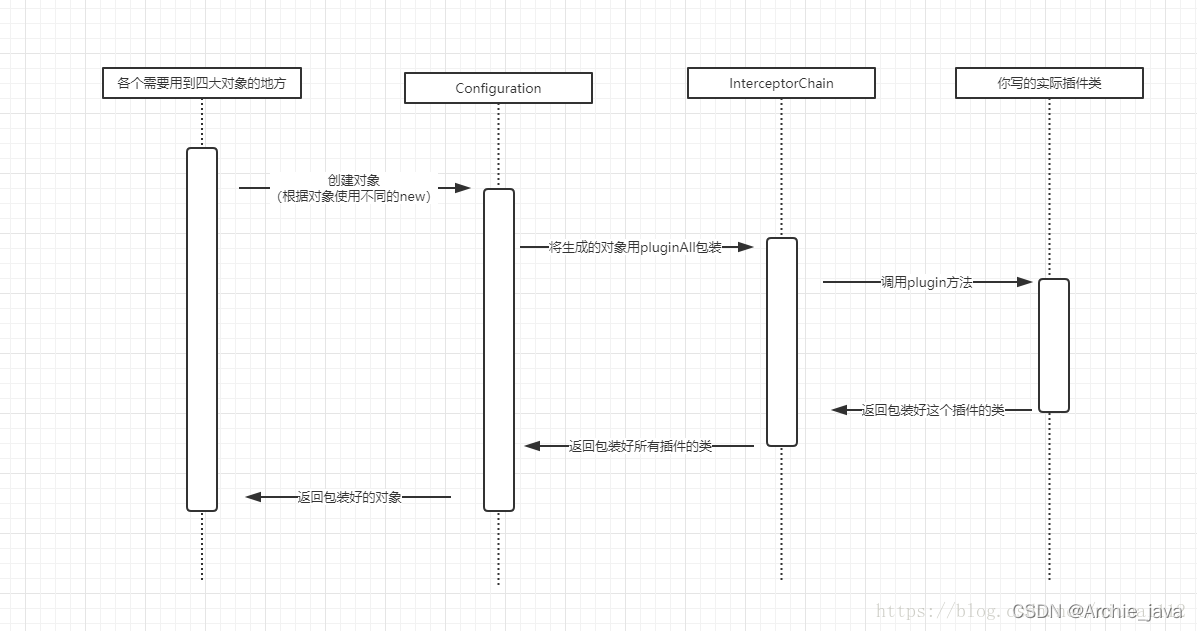文章目录
- 前言
- InterceptorChain保存所有的Interceptor
- 创建四大对象都走Configuration
- InterceptorChain增强对象方法
- Plugin封装动态代理,让你使用Mybatis拦截器更简单
- Invocation,让我们能在拦截器中使用动态代理类中的invoke方法中的对象
- 调用时序图
- 小结
前言
mybatis拦截器是一个非常有用的功能,当你想实现自动分页,自动记录执行的sql等功能时,若在service层,每次调用时,都写代码的话,会非常麻烦,而使用mybatis拦截器,就可以非常轻松的实现了。
Executor , ResultSetHandler,StatementHandler,ParameterHandler,这是Mybatis中的四大对象,也是拦截器的切入点。我们可以基于这四大对象的方法进行增强。解释一下,因为这四个都是接口,我们可以利用动态代理进行方法的增强。
动态代理,这是底层的原理,若只用了动态代理,那么你肯定要自己写代理类,在使用的时候实例化,然后再替换Mybatis里面的原有对象,对不?但是实际你并不需要这么做,那是因为mybatis一开始就为你设计好了让你如何简单快速的添加拦截器,让你在添加拦截器的时候只用关注业务逻辑,而不需要管类之间的关系。
那么Mybatis究竟是怎么做到这一点的呢?接下来就让LZ带大家来看看Mybatis究竟是如何实现的吧。
我们实现mybatis拦截器的步骤,首先创建Interceptor的实现类,然后我们要在mybatis.xml中配置plugins,这就是我们为Mybatis添加拦截器的步骤。
InterceptorChain保存所有的Interceptor
我们来到Configuration类中,看到里面他有个属性叫InterceptorChain,里面是用来存放我们的所有拦截器,针对四大对象的拦截器全部在里面。
//这里就是解析并把plugin加入到interceptorChain中private void pluginElement(XNode parent) throws Exception {if (parent != null) {for (XNode child : parent.getChildren()) {String interceptor = child.getStringAttribute("interceptor");Properties properties = child.getChildrenAsProperties();Interceptor interceptorInstance = (Interceptor) resolveClass(interceptor).newInstance();interceptorInstance.setProperties(properties);configuration.addInterceptor(interceptorInstance);}}}//加入到interceptorChainpublic void addInterceptor(Interceptor interceptor) {interceptorChain.addInterceptor(interceptor);}
创建四大对象都走Configuration
然后,Mybatis在创建四大对象的时候都是走的Configuration类中的方法
//创建ParameterHandler对象public ParameterHandler newParameterHandler(MappedStatement mappedStatement, Object parameterObject, BoundSql boundSql) {ParameterHandler parameterHandler = mappedStatement.getLang().createParameterHandler(mappedStatement, parameterObject, boundSql);//都有interceptorChain.pluginAll()parameterHandler = (ParameterHandler) interceptorChain.pluginAll(parameterHandler);return parameterHandler;}
//创建ResultSetHandler对象public ResultSetHandler newResultSetHandler(Executor executor, MappedStatement mappedStatement, RowBounds rowBounds, ParameterHandler parameterHandler,ResultHandler resultHandler, BoundSql boundSql) {ResultSetHandler resultSetHandler = new DefaultResultSetHandler(executor, mappedStatement, parameterHandler, resultHandler, boundSql, rowBounds);//都有interceptorChain.pluginAll()resultSetHandler = (ResultSetHandler) interceptorChain.pluginAll(resultSetHandler);return resultSetHandler;}
//创建StatementHandler对象public StatementHandler newStatementHandler(Executor executor, MappedStatement mappedStatement, Object parameterObject, RowBounds rowBounds, ResultHandler resultHandler, BoundSql boundSql) {StatementHandler statementHandler = new RoutingStatementHandler(executor, mappedStatement, parameterObject, rowBounds, resultHandler, boundSql);//都有interceptorChain.pluginAll()statementHandler = (StatementHandler) interceptorChain.pluginAll(statementHandler);return statementHandler;}
//创建Executor对象public Executor newExecutor(Transaction transaction, ExecutorType executorType) {executorType = executorType == null ? defaultExecutorType : executorType;executorType = executorType == null ? ExecutorType.SIMPLE : executorType;Executor executor;if (ExecutorType.BATCH == executorType) {executor = new BatchExecutor(this, transaction);} else if (ExecutorType.REUSE == executorType) {executor = new ReuseExecutor(this, transaction);} else {executor = new SimpleExecutor(this, transaction);}if (cacheEnabled) {executor = new CachingExecutor(executor);}//都有interceptorChain.pluginAll()executor = (Executor) interceptorChain.pluginAll(executor);return executor;}
观察上面的四个函数,他们都有一个共有的点,调用了interceptorChain.pluginAll()方法,这也是Mybatis实现拦截器功能的中点,这个pluginAll(),使拦截器有了一个特性,那就是逻辑可以向下传递,是责任链模式。
InterceptorChain增强对象方法
public class InterceptorChain {private final List<Interceptor> interceptors = new ArrayList<Interceptor>();public Object pluginAll(Object target) {//通过for循环遍历interceptors,将所有的interceptor都加进去。//一层包一层,直到所有的interceptor都包装好for (Interceptor interceptor : interceptors) {target = interceptor.plugin(target);}return target;}public void addInterceptor(Interceptor interceptor) {interceptors.add(interceptor);}public List<Interceptor> getInterceptors() {return Collections.unmodifiableList(interceptors);}}
这里进去的对象,和出来的对象已经不是同一个了。进去的基础四大对象,出来的是增强版四大对象。
这里其实用到了责任链模式,每个Interceptor 都有自己要服务的对象,只有当请求的方法和Interceptor要服务的对象匹配时,它才会执行,你拦截器里的方法。
接下来LZ带大家来看看Mybatis是怎么比对两个对象是否匹配的。
Plugin封装动态代理,让你使用Mybatis拦截器更简单
我们去Plugin类中
//看到这个类,大家有没有觉得很熟悉,没错,实现了InvocationHandler ,使用动态代理
//这个就是Mybatis实现拦截器功能的底层。
public class Plugin implements InvocationHandler {private Object target;private Interceptor interceptor;private Map<Class<?>, Set<Method>> signatureMap;private Plugin(Object target, Interceptor interceptor, Map<Class<?>, Set<Method>> signatureMap) {this.target = target;this.interceptor = interceptor;this.signatureMap = signatureMap;}
//我们不需要手动的实例化动态代理对象,是因为wrap为我们做了这件事public static Object wrap(Object target, Interceptor interceptor) {//这句也蛮重要的,是将我们写的拦截器类的注解转换成了map,key为我们的类对象,value是方法//为了之后判断是否需要执行拦截器的方法//这句就不进去仔细分析了,因为很简单,就是解析注解而已Map<Class<?>, Set<Method>> signatureMap = getSignatureMap(interceptor);Class<?> type = target.getClass();Class<?>[] interfaces = getAllInterfaces(type, signatureMap);//这里实例了动态代理对象 return interfaces.length > 0 ? Proxy.newProxyInstance(type.getClassLoader(), interfaces, new Plugin(target, interceptor, signatureMap)) : target;}
}public Object invoke(Object proxy, Method method, Object[] args) throws Throwable {try {//获得方法Set<Method> methods = (Set)this.signatureMap.get(method.getDeclaringClass());//如果方法不为空,说明这个对象确实有拓展拦截器,之后看method是不是有这个方法,有的话才说明这个方法确实被拓展了,之后执行interceptor.intercept()即调用拦截器的方法return methods != null && methods.contains(method) ? this.interceptor.intercept(new Invocation(this.target, method, args)) : method.invoke(this.target, args);} catch (Exception var5) {throw ExceptionUtil.unwrapThrowable(var5);}}
Invocation,让我们能在拦截器中使用动态代理类中的invoke方法中的对象
//通过这个对象,把代理类中的invoke方法中的对象和我们拦截器类相连。
//我们在拦截器类中的intercept(Invocation invocation)中的invocation就是这个类型
//所以我们就能在拦截器类中获取到代理类中的各个对象啦
public class Invocation {private Object target;private Method method;private Object[] args;public Invocation(Object target, Method method, Object[] args) {this.target = target;this.method = method;this.args = args;}public Object getTarget() {return target;}public Method getMethod() {return method;}public Object[] getArgs() {return args;}public Object proceed() throws InvocationTargetException, IllegalAccessException {return method.invoke(target, args);}}
调用时序图

小结
总结一下,其实底层用到的还是动态代理,但是Mybatis通过封装,让我们开发拦截器更加简单。通过InterceptorChain,使得拦截器能将逻辑向下传递,然后通过Invocation,让拦截器类能使用到动态代理类invoke中的对象。
Mybatis一级缓存和二级缓存的实现)

方法)










方法实例)





